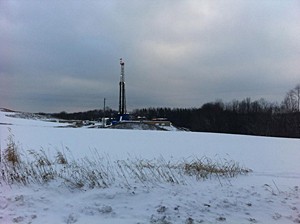
Tapping a Valuable Resource or Invading the Environment? Research Examines the Start of Fracking in Ohio
A new study is examining methane and other components in groundwater wells, in advance of drilling for shale gas thats expected over the next several years in an Ohio region.
Amy Townsend-Small, a University of Cincinnati assistant professor of geology, will present on the study on Sept. 27, at the 10th Applied Isotope Geochemistry Conference in Budapest, Hungary.
The team of UC researchers spent a year doing periodic testing of groundwater wells in Carroll County, Ohio, a section of Ohio that sits along the shale-rich Pennsylvania-West Virginia borders. The study analyzed 25 groundwater wells at varying distances from proposed fracking sites in the rural, Appalachian, Utica Shale region of Carroll County. Because the region is so rural, the majority of the population relies on groundwater wells for their water supply.
This is a major area for shale gas drilling in Ohio, and one reason is because shales in the area are thought to have a good amount of liquid fuel as well as natural gas, says Townsend-Small.
The researchers are currently analyzing samples from groundwater wells over a one-year period, with water samples drawn every three-to-four months.
The samples are being analyzed for concentrations of methane as well as hydrocarbons a carcinogenic compound and salt, which is pulled up in the fracking water mixture from the shales, which are actually ancient ocean sediments.
Were examining changes over time resulting from fracking, and since this is just beginning in Ohio, we have the opportunity to make some baseline assessments, says Townsend-Small.
Hydraulic fracturing, or fracking, involves using millions of gallons of water mixed with sand and chemicals to break up organic-rich shale to release natural gas resources. Proponents say fracking promises a future in lower energy prices, cleaner energy and additional jobs amid a frail economy. Opponents raise concerns about the practice leading to increased methane gas levels (known as the greenhouse gas) and other contamination resulting from spillover of fracking wastewater of groundwater in shale-rich regions.
Townsend-Small explains that some groundwater wells naturally hold a certain level of methane due to the decomposition of organic matter. Its not toxic in drinking water, but high levels can result in explosion. The study includes measurements of stable isotopes, which can indicate whether methane is derived from natural organic matter decomposition or from fossil fuels.
Other chemicals in fracking wastewater are toxic and dangerous for drinking water. Future UC research includes measurements of some of these compounds, as fracking progresses in the region.
The
U.S. Energy Information Administration
reported this summer that natural gas reserve additions in 2011 ranked as the second-largest annual increase since 1977, with hydraulic fracturing adding to increased oil and gas reserves.
The Ohio Department of Natural Resources reports that 882 sites in the state of Ohio have been awarded permits for fracking. In Carroll County, 327 sites have been awarded permits and 236 have been drilled.
Funding for the UC study was supported in coordination with UC Foundation by a $20,000 grant from the Missouri-based Deer Creek Foundation, a $2,500 grant from the Cincinnati-based David and Sara Weston Foundation and an $85,714 grant from the Ohio Board of Regents.
Townsend-Small and her colleagues in the UC Department of Geology were also awarded a $400,000, 3-year grant from the National Science Foundation (EAR-1229114) for an isotope ratio mass spectrometer. The instrument measures the stable isotope composition of methane, which can indicate whether it is derived from biological activity or natural gas.
Collaborators on the study are David Nash, a UC professor of geology, and Erin Haynes, an assistant professor of environmental health in the UC College of Medicine.
Related Stories
UC offers experiential learning abroad in Central America
April 19, 2024
In the tropical paradise of Costa Rica, fourth year journalism and international affairs student Stephanie Rivera embarked on an unforgettable journey of self-discovery and cultural immersion. Leaving behind the familiar sights and sounds of Cincinnati, Rivera set out to study abroad for a transformative semester in this Central American country, rich with vibrant biodiversity and cultural heritage. The College of Arts & Sciences (A&S) at UC places great emphasis on encouraging study abroad and experiential learning opportunities for its students. Recognizing the transformative power of global experiences, the college supports a variety of study-abroad programs that enable students to enhance their academic pursuits while gaining valuable cultural and personal experiences.
Alabama.com: How a new self-test for HPV could be a game changer
April 19, 2024
The University of Cincinnati's Leeya Pinder was featured in an Alabama.com/Reckon article about how self-testing for HPV could make preventative care more accessible to those facing the most barriers.
WVXU: Test your word puzzle skills with a Cincinnati...
April 18, 2024
Cincinnati edition host Lucy May discusses the history and new found popularity of word games with Michael Griffith, professor English. Griffith is a writer, but also develops word games for publication.
